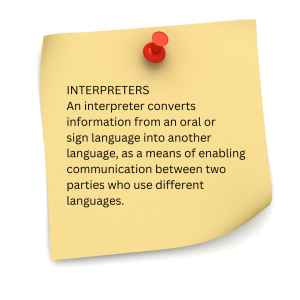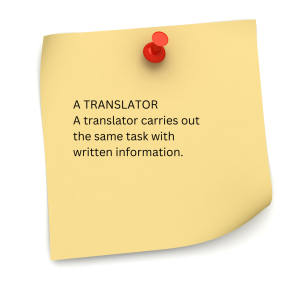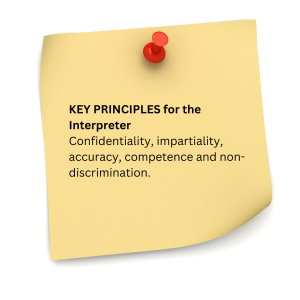Chapter 28 – Deirdre Berry (D2SOP5)
Domain 2 Standard of Proficiency 5
Be able to recognise when the services of a professional translator are required.
|
KEY TERMS Cultural diversity Cultural diversity in domestic violence services Gender-based violence Lost in translation Who should translate?
|
Social care is … the provision of care to vulnerable and marginalised groups of individuals in our society. Social care workers advocate, guide and support their client groups. Social care incorporates a wide range of service provision, based on the principles of respect, dignity, inclusion and empowerment. To achieve the best outcome, social care workers must apply a meaningful and genuine interest in working towards better outcomes for a person. Social care work is not about just providing care but also being caring. It is the skill of developing relationships while maintaining boundaries. |
Cultural Diversity: The Changing World We Work in
The people of Ireland are scattered all over the world; many Irish people have migrated to other counties during times of famine, war and economic crisis. Irish society has become increasingly diverse, as many other nationalities have migrated to Ireland to live. In April 2020, there were an estimated 644,400 non-Irish nationals resident in Ireland, originating from 200 different counties, and accounting for 12.9% of the total population (CSO 2020). This creates a vibrant melting pot of cultures, languages, religions and experiences. In Ireland, unlike countries such as Australia that have specific written guidelines in place for the provision of interpreting and translation, there is a lack of written policies for government departments and agencies and a lack of guidelines for staff on when and how to use interpreters. This is not to say, however, that there is a complete absence of policy, as there are obligations under the European Convention on Human Rights, which must be adhered to for legal process; the Refugee Act 1966; and, more generally, the Equal Status Acts 2000-2004.
Social care, in its essence, is a body of trained professionals who plan and provide quality care and support to vulnerable individuals and groups of all ages experiencing marginalisation, disadvantage and/or special needs, irrespective of their culture or language. Social care work utilises problem-solving and task-centred approaches, which guide and advocate for service users to support, empower and sometimes challenge them to overcome diversity. This can become more complex when service users speak a different language. To do this work, social care workers use a suite of tools and communication skills including body language, tone of voice, eye contact, touch, the written and spoken word. Providing accessible information in a range of user-friendly formats to all service users is an integral approach to service delivery in every social care setting. Such information assists those who may not be functionally literate, may have hearing or sight impairments, may not be competent in the English language, or who may need information presented in plain English. The principal objective of the social care worker is to support service users to reach their full potential and sometimes this might include knowing when to enlist the services of another professional. Speaking a different language, or lack of access to a professional translator or interpreter, should not be a barrier to people getting the support they need.
|
SOME TOOLS AND TIPS THAT CAN HELP WHEN LANGUAGE IS A BARRIER |
|
Google Translate can be used for immediate translation in a crisis response or to translate a message. |
|
Some services have translation services: hospitals/the Gardaí/courts have interpreters they can access. Women’s Aid has a translation service, which can be accessed through its helpline: 1800 341 900 |
|
HSE Multilingual Resources and Translated Information can be found on the HSE website, with many translated leaflets available. |
TASK 1
Talk to someone in your class, workplace or community for whom English is not their first language. Use Google Translate to translate a sentence from English into their first language and ask about the accuracy of the translation, and what information is lost in the translation.


Interpreters and translators can help us understand our service users, accurately ascertain their needs and appropriately communicate professional opinions and relevant information about their care. An interpreter speaks more than one language and can help to communicate with service users when English is not their first language.
Cultural Diversity in Domestic Violence Service
I have worked predominantly in frontline and management roles, in the area of gender-based violence (GBV), within a domestic abuse support service for women and children. It is mainly a crisis intervention service. I will draw on my experience of this setting throughout this chapter to give practice scenarios of working with families when English is not their first language. If you are unfamiliar with the work we do, I have included the following short segment.
Case Study 1
Background to a Domestic Violence Service
The service I work in provides a 24-hour helpline, emergency refuge accommodation, outreach and court services and a specialised children’s service to women and children. However, as well as supporting women and children directly we also provide specific expertise in safety planning; connect and accompany women through medical, legal, financial, immigration, employment, educational and social services; and provide direct care to traumatised women and children in refuge and other residential settings. We also work to challenge organisational policies, institutional values, and/or public attitudes to improve system responsiveness to women in abusive relationships. We provide training to partners such as gardaí and other civil service personnel, design public relations campaigns, and talk to students in local education systems. Logical reasoning and problem-solving is at the core of our practice every day. It is a service user-led service, which essentially means that every person who enters the service gets a bespoke service. This is key to our work as every person is unique and has had unique experiences and needs. Historically, most of the domestic violence and abuse services in Ireland have been developed from a grassroots response to the needs of women and children in communities to a nationally organised response. The services were developed as survivors and advocates lobbied for responses, services and pathways to safety for women experiencing violence in their home. In recent years Ireland has evolved in its provision of responses for people experiencing domestic violence with the Domestic Violence Act 2018 replacing the Domestic Violence Act 1996 and the Domestic Violence (Amendment) Act 2002. This brought positive and significant changes, many of which have been petitioned for by domestic abuse advocates for a long time. Changes in guidelines, such as extension eligibility for orders and intimate relationship being considered an aggravating circumstance in sentencing, were introduced, ultimately improving the protections available to victims of domestic violence under both the civil and criminal law. Moreover, from January 2019 coercive control became a criminal offence in Ireland. This development gave recognition and grounding to the destructive patterns of abusive behaviours. The standardisation and professionalisation of the domestic abuse sector has also opened the door to the social care sector, with many services modelling their service on the social care model. In fact, social care is the discipline that is most sought after in the domestic, sexual and gender-based violence (DSGBV) sector.
Social care workers are part of the multi-disciplinary team within domestic abuse support services. Over the past 15 years I have supported many migrant women. Coming to live in a new country is filled with many hopes and challenges; a new language, opportunities, different social policies, little or no family or social support systems, status, to name a few. Facing everyday challenges without a support network can easily lead to difficulties. This is where the social care service (care homes, homeless services, family support, addiction supports and mental health services) will meet many migrant persons facing adversity. Some migrant women may not have travelled willingly, may have been trafficked or misled into a false promise of marriage, employment or a life free of war and hardship. Those who seek asylum in another country may have experienced war, conflict-based rape and/or rape, abuse and terror in their country of origin or during the migration journey. I have witnessed women arrive to the refuge door, some with small children, some older women, some women who are still in their teens, who are afraid, upset, hurt, confused; they are traumatised. Their situation becomes a lot more challenging when they have little or no English.
Gender-based Violence
All genders can experience domestic abuse. I work specifically, in a gendered approach, with women and children, therefore my practice reflection will be through a gendered lens of my work with women and children. Gender-based violence (GBV) is one of the most prevalent social problems in the world. Not only is it a violation of women’s human rights, but it also has devastating physical and psychological health consequences for victims/survivors (WHC 2007). It is complex in its various forms (physical, emotional, financial, sexual, social and coercive control); additionally, other difficulties can add to its complexities, such as mental health, addiction, cultural and religious beliefs and socio- economic background. All of which can be barriers to safety. European research suggests that one in three women (33%) have experienced physical and/or sexual violence (FRA-EUAFR 2015). Women’s Aid reports that one in four women in Ireland who have been in a relationship have been abused by a current or former partner. While all women are at risk of experiencing it, a range of factors place minority ethnic women at higher risk than the rest of the population. They include the twofold discrimination of gender and ethnic origin, migrant status, increased isolation and social norms that are defined by patriarchal values. Some minority ethnic women come from cultures where harmful traditional practices are carried out, such as female genital mutilation (FGM) and forced marriage.
While services in the DSGBV sector provide specialised services, domestic abuse and violence will, due to its prevalence, commonly present as an issue in most social care settings. For example, in residential care, domestic abuse could have been a presenting issue in the child’s family of origin; in youth work, patterns of abusive or unhealthy relationships may surface and support or educational programmes may be necessary. The double discrimination of gender and racism has created a situation in which minority ethnic women are not always able to access the services they need. In addition, their economic and social circumstances, as well as migration and residence laws, may militate against their ability to access services. Additionally, living in a home where there is domestic abuse and coercive control can make a person feel extremely isolated and afraid. Not being able to speak the common language and an absence of interculturally competent services exacerbates this and leaves the person in a very vulnerable situation. For many migrant women, when they reach out for help, it is when things have come to a very difficult and dangerous point.
Lost in Translation

As social care workers we rely on our humanity to connect with people. We then deploy our skills and knowledge to support the people accessing our services. In those moments of crisis, when a person reaches out for help, we must respond by de-escalating the situation enough to act effectively.
De-escalate the situation:
- Show empathy and provide reassurance
- Remain calm
- Help them self-regulate (sit, breath)
- Offer caring gestures (tissue, drink of water/tea)
Assess the situation:
If the person is traumatised, the social care worker must assess if the trauma is a factor in their ability to communicate. Trauma can impact people in different ways. A person may present stunned, non-verbal, withdrawn, distant, confused, upset or crying, rambling, confused, shouting, talking rapidly, frustrated. Once the person is somewhat calm and can start to communicate, the social care worker must figure out if they can understand some English. Establishing names, country/ language they speak is a good starting point. It may not be possible to get an interpreter in that moment so using other communication tools can help provide reassurance. Google Translate/ translation apps on mobile devices are helpful. As there are so many language variations, even within one country, Google Translate can help identify the specific language spoken, which will assist when arranging an interpreter.
Within many social care settings, for example a refuge environment, assessing health and wellbeing may need to be the first response. If a person presents with visible injuries medical assistance should be provided. However, in the context of domestic abuse some injuries may not be visible, if the person has been sexually assaulted or assaults are intentionally not carried out on obvious or visible areas of the body. Be cautious if offering other services; this may frighten the service user, especially if they do not understand the context of the conversation or if their status in the country is linked to another person.
Who Should Translate?
If there is any doubt that the person does not fully understand the conversation, a translator should be enlisted. Some people who are frightened and unsure may give the impression that they know what you are saying. Clarity and understanding should be sought. Be aware that service users may not want to use an interpreter and may prefer to use a family member or friend. Children can often become language brokers for their non-English-speaking parents. Using children to interpret should be avoided. Children must be protected from harm, as outlined in Children First guidelines, and interpreting may cause distress and trauma for the child. Using adult family or friends has its advantages and disadvantages; additional information may be shared if family members interpret for one another; service users may mistrust using an unknown professional interpreter (Lucas 2014). Nevertheless, issues of collusion and accuracy have been identified when informal interpreters have been used in public services, resulting in errors and compromised meaning (Lucas 2015; Dorner et al. 2010). In the case of domestic abuse disclosures, some service users may not want to disclose details of their abuse, to protect the friend or family member or because they feel ashamed. There are also concerns about interpreters’ availability and confidentiality breaches (Sawrikar 2013). This may present in small tight-knit communities. One example of this occurred when the court interpreter was known to a woman I supported. This woman was applying for a domestic violence order. The incident caused huge distress for the woman, and resulted in her withdrawing from accessing the court order for protection. This also left her in an unsafe situation, worrying if the interpreter would tell her partner of their encounter.  Interpreters contribute to assessment and intervention processes by facilitating communication, and by doing so, they gain insight into service users’ experiences, perspectives, wishes and feelings. Discrimination and oppression are common experiences for emergent bilinguals, thus facilitating communication is an anti-racist and anti-oppressive practice issue. Ensuring that services are provided in a suitable format and facilitating communication is helpful in recognising people’s language, history, culture, traditions and religion (Keating 2000). Using an interpreter when language is an issue is important to ensure understanding and gain clarity. This is particularly important when completing risk assessments, informing service users of their rights, in child protection issues, for consent to engage in services or share information to other services, and in line with General Data Protection Regulations (GDPR).
Interpreters contribute to assessment and intervention processes by facilitating communication, and by doing so, they gain insight into service users’ experiences, perspectives, wishes and feelings. Discrimination and oppression are common experiences for emergent bilinguals, thus facilitating communication is an anti-racist and anti-oppressive practice issue. Ensuring that services are provided in a suitable format and facilitating communication is helpful in recognising people’s language, history, culture, traditions and religion (Keating 2000). Using an interpreter when language is an issue is important to ensure understanding and gain clarity. This is particularly important when completing risk assessments, informing service users of their rights, in child protection issues, for consent to engage in services or share information to other services, and in line with General Data Protection Regulations (GDPR).
For example, information for a woman accessing a refuge in crisis:
This is a refuge, women and children who are hurt or afraid at home can stay here. You are safe here. I work here, and it is my job to help you. If you are afraid, we will not tell anyone you are here. Can you tell me how I can help you …Engaging the services of an interpreter can be time-bound. Whether over the phone or in person, the interpreter will have a set time with you to provide their services. Preparation for this will ensure the time is used effectively. Write down the information you need to provide to the service user and write down the questions you need to ask them.
Be mindful that you can enlist an interpreter again, at a later stage, so do not overwhelm the service user with too much information. Keep the information specific and deal with the most pressing issues.
It may help to clarify at the start of the first meeting that the interpreter is a professional doing their job, has no decision-making powers and is bound by the confidentiality policy of the agency. Speak directly to the service user, rather than to the interpreter. Many more sessions may be required as the service user’s needs are identified. Once the crisis point has passed, communication will increase as trust and the feeling of safety grows. For more practical tips for using translation services see the resources listed at the end of this chapter.
Funding and access to translation services or an interpreter must be considered. Some partner services have access to these services; however, all services should work towards having their information translated into the most used languages. Services should also have guidelines for staff detailing when and how to enlist translation and interpreter services.
Conclusion
Our society is growing rapidly and with this growth diversity blossoms. Our social services must be able to support all persons in our society. Communication and Language is the seed that must be present in order to assess and meet the needs of all persons. Every person has the right to have their voice heard; it is up to us to enable this process, to support and ultimately assist them to overcome the adversity they are facing. Engaging and working with other cultures can create learning and new experiences that enrich services and the people in them. Having services that are accessible to all persons ensures inclusiveness and diversity. Training staff in diversity, equality and inclusion can help build awareness of unconscious bias, cultural competence, or other barriers to diversity, equity, inclusion and belonging. It can also motivate positive behaviours and attitudes. Reflection and sharing learning can also add to this growth.
Useful recommendations for interpreting and translating services:
- The National Consultative Committee on Racism and Interculturalism (NCCRI) report, ‘Developing Quality Cost-effective Interpreting and Translating Services for Government Service Providers in Ireland’ (2008), https://www.atii.ie/publications/articles-reports/page/2/
- HSE Multilingual Resources and Translated Material Information, https://www.hse.ie/eng/about/who/primarycare/socialinclusion/about-social-inclusion/ translation-hub/multilingual-resources-and-translated-material/
- Lost in Translation? Good Practice Guidelines for HSE Staff in Planning, Managing and Assuring Quality Translations of Health-related Material into Other Languages, https://www.hse.ie/eng/services/publications/socialinclusion/lostintranslationreport.pdf
- On Speaking Terms: Good Practice Guidelines for HSE Staff in the Provision of Interpreting Services, https://www.hse.ie/eng/services/publications/socialinclusion/emaspeaking.pdf
![]() Tips for Practice Educators
Tips for Practice Educators
Working in the DSGBV sector can be both challenging and rewarding. Student placements in this setting can yield rich learning not only about domestic abuse but also in many interconnecting areas of social care, such as social policy, as we support the service users through social welfare, housing and immigration issues. It also exposes students to the legal and justice processes, navigating working with the Gardaí, legal aid and court procedures. Students may also learn and practise risk assessing, care planning, reflection and child protection. Building meaningful relationships is the essence of our work in DV services, and within all social care settings. Students can certainly have an opportunity to practise this.
Preparation for placements
In my experience, students starting a placement in a GBV service may become overwhelmed. Walking into the setting, which is normally buzzing with families and small children, and meeting the team is the first taste of the reality of women and children fleeing their own home due to fear, violence and abuse at the hands of those who should provide love and care. Taking some time to process this before starting placement will prepare the student.
Knowledge of the law, particularly the Domestic Violence Act, and in relation to coercive control and other types of violence, is also essential.
Most GBV services will have student handbooks and student placement co-ordinators and mentors. Students should seek them out.
In our service, we accommodate students on placement from third and fourth year. We have found at this stage in their studies students have a broader learning base and the maturity needed to complete the placement successfully.
As the GBV sector grows it is opening many more employment opportunities for social care professionals, and new research and publications also allow for rich learning for students.
References
CSO (Central Statistics Office) (2020) ‘Population and Migration Estimates’, April. Available at <https://www.cso.ie/en/releasesandpublications/er/pme/populationandmigrationestimatesapril2020/>.
Dorner, L.M., Orellana-Faulstich, M. and Jiménez, R. (2010) ‘“It’s one of those things that you do to help the family”: Language brokering and the development of immigrant adolescents’, Journal of Adolescent Research 23(5): 515-43.
FRA – European Union Agency for Fundamental Rights EUAFR (2015) Violence against women: an EU- wide survey. Luxembourg: Publications Office of the European Union. Available at https://fra.europa. eu/sites/default/files/fra_uploads/fra-2014-vaw-survey-main-results-apr14_en.pdf.
Keating, F. (2000) ‘Anti-racist perspectives: what are the gains for social work? Social Work Education, 19, 1, 77 87
Lucas, S.E. (2014) ‘Social Work in a Multilingual World: Interpreter-mediated Encounters’. Unpublished doctoral dissertation, University of Salford.
Lucas, S.E. (2015) ‘Child interpreting in social work: competence versus legitimacy, Transnational Social Review 5(2): 145-60.
Sawrikar, P. (2013) ‘How effective do families of non-English-speaking background (NESB) and child protection caseworkers in Australia see the use of interpreters? A qualitative study to help inform good practice principles’, Child and Family Social Work 20(4): 396-406.
WHC (Women’s Health Council) (2007) Violence Against Women and Health. WHC: Dublin. Website: www.whc.ie.
WHC (2009) Translating Pain into Action: A Study of Gender-based Violence and Minority Ethnic Women in Ireland. Dublin: WHC. Available at <https://www.womensaid.ie/assets/files/pdf/whc_gender_based_ violence.pdf>.

